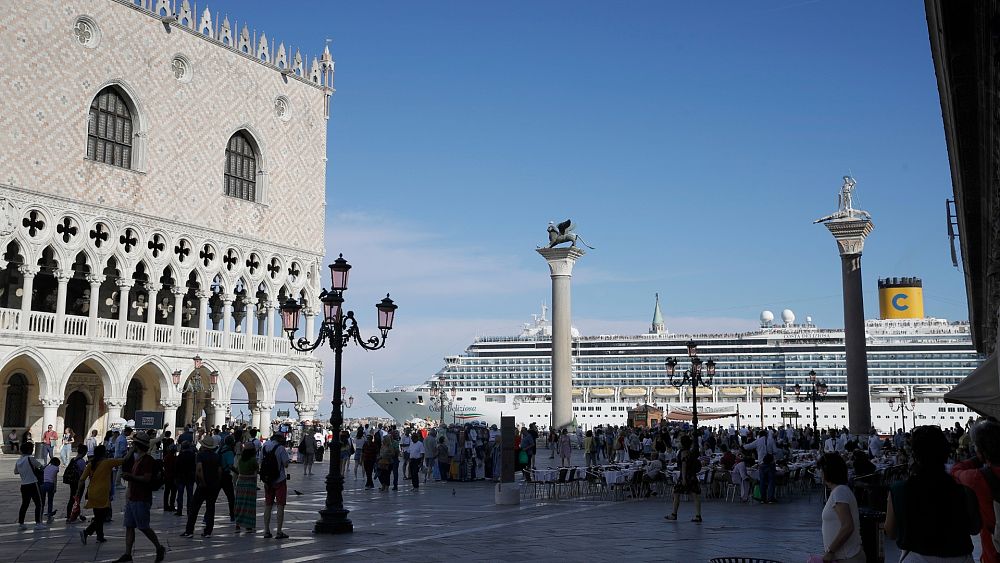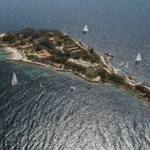Destinations grappling with overtourism are putting an end to ships carrying toxic emissions and millions of passengers.
Every year more than 20 million passengers take a cruise.
Before the pandemic, that number was even higher at around 30 million.
As passenger numbers appear to once again exceed this pre-pandemic number, many European ports where these ships drop anchor are reevaluating their presence. Some are trying to ban them altogether, citing environmental, social and economic concerns.
And, with the benefits to the local economy in question, the millions of passengers they bring to European cities every year are causing problems for the people who live there.
Contenuti
ToggleVenice wants to keep cruise ships out of the city
In 2021, Venice has banned large cruise ships from anchoring in its historic center.
The damage to the lagoon saw UNESCO threaten to put the city on its endangered list unless they were permanently banned.
They argue that large ships cause pollution and erode the foundations of the city, which already suffers from regular flooding. The ban means large cruise and container ships can no longer enter Venice's Giudecca canal.
There have been attempts to stop large ships before with the reversal of previous legislation. But the pressure increased when in 2019 a cruise ship crashed in the port of Venice, injuring five people.
And by the time of the 2021 ban, cruise lines were on board, too. After the announcement, the Cruise Lines International Association (CLIA) said it had “advocated a new approach for many years” calling it a “big step forward.”
However, the reality of the blockade of large ships from Venice turned out to be more complicated than it might initially have seemed. Without a new hub outside the city lagoon for cruise lines to use, many are still docked there two years after the ban took effect.
Which European Cities Ban Cruise Ships?
However, pollution and excessive tourism are not just a problem in Venice.
Barcelona, as it moves to address its own problems, closed its North terminal to cruises on October 22. Around 340 ships a year will now have to dock at the Moll d'Adossat pier, the furthest from the city's population centres.
Following the closure of another terminal located in Maremagnum and the introduction of the one ship per terminal rule, only seven cruise ships can now dock in Barcelona at the same time.
These measures follow an agreement with local authorities to move cruise ships out of central Barcelona in a bid to mitigate the impact of overtourism.
The South terminal will also close by 2026 and all cruises will operate from the Adossat pier.
The Mediterranean is the second largest market for cruises outside the Caribbean and the increase in passenger numbers is putting a strain on local populations.
In 2022, 50,000 people in Marseille – The largest cruise port in France – signed a petition against cruise ships, according to the militant group Stop Croisières.
Passengers have encountered protests in the Balearic city of Palma de Mallorca and new limits have been introduced allowing only three ships to enter its port at once.
Santorini and Dubrovnik have also tightened restrictions on cruise lines.
Where else do cruises cause problems?
A crackdown is also underway in the most popular ports outside the Mediterranean.
Cruise ships visiting Scotland will be charged a new tax under plans recently announced by the country's Green Party. It is claimed the tax will address the “double challenge” of emissions and overtourism.
Lorna Slater, co-leader of the Scottish Greens, also said she hoped the cruise tax would encourage companies to use less polluting ships, arguing that one ship produces the same emissions as 12,000 cars.
“Operators have been allowed to get away with pollution for too long,” Slater added.
In Amsterdam, the city council has just voted to close the cruise terminal in an effort to curb pollution and reduce the number of tourists.
Moving the terminal off center seems like the most likely solution. But the vote reflects the city's feelings about these large passenger ships.
Earlier this year, local political leader Ilana Rooderkerk likened cruise passengers descending on the city to a “plague of locusts.”
Amsterdam introduced a tax on cruise ship passengers in 2019, a move that has seen some companies replace or cancel stops in the city. Every year more than 100 ships dock in the Dutch capital and have become its symbol problems of local overtourism.
Do cruise ships bring money where they dock?
One of the biggest arguments advocates make in favor of keeping cruise ships is theirs contribution to the local economy.
But do guests on these giant ships really spend money in the cities where they dock?
Several studies have shown that passengers disembarking from ships do not contribute as much to the local economy as one might think. With all the food, drinks and souvenirs they might want on board, the money remains at sea.
It's no surprise when you discover that the world‘s largest cruise ship, the Wonder of the Seas, has a staggering 20 restaurants, a 1,400-seat theater and shops selling everything from fine watches to high fashion. Depending on the package you choose, food and drinks are often included and purchases are free of taxes and duties.
An even larger ship, the 365-meter-long Icon of the Seas, will be launched next year.
A study from Bergen, Norway – a popular stop on fjord tours – found that up to 40% of people never left the ship. For those who disembarked, the average expense was less than 23 euros.
Further research conducted in the Norwegian city in 2013 found that length of stay was likely one of the most important factors in passenger spending.
The average stay in port lasts around eight hours but can vary considerably depending on the ship's itinerary. For some – like Barcelona – can last as little as four hours.
And spending remains low even when passengers are given more opportunities to spend their money.
The cruise industry says the average passenger's contribution to the local economy is much higher than Bergen's estimate of around $100 (91 euros) a day.
One way to close the gap would be to increase the passenger tax collected at ports, which currently tends to be between 4 and 14 euros per person.
The cruise industry says it's moving improve both its environmental and social impact.
According to CLIA, cruise lines were among the first companies in the shipping industry to commit to reducing carbon emissions by 40% by 2030. Some have even signed a pledge to reach net zero by 2050.
Electrifying ports so ships can turn off their engines and limit toxic emissions could also help. It's something Barcelona is considering in its plan to move cruise ships out of the city by 2026, allowing ships to dock at the Adossat dock.
However, it remains to be seen whether these goals will be enough to appease the tired inhabitants of port cities.
Image:Getty Images







